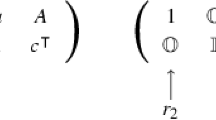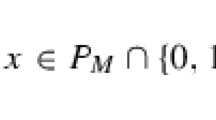Abstract
Given m matroids M 1,..., M m on the common ground set V, it is shown that all maximal subsets of V, independent in the m matroids, can be generated in quasi-polynomial time. More generally, given a system of polymatroid inequalities f 1(X) ≥ t 1,..., f m(X) ≥ t m with quasi-polynomially bounded right hand sides t 1,..., tm, all minimal feasible solutions X⊆V to the system can be generated in incremental quasi-polynomial time. Our proof of these results is based on a combinatorial inequality for polymatroid functions which may be of independent interest. Precisely, for a polymatroid function f and an integer threshold t ≥ 1, let α = α(f,t) denote the number of maximal sets X ⊆ V satisfying f(X) < t, let β = β(f t) be the number of minimal sets X ⊆ V for which f(X) ≥ t, and let n = |V|. We show that α ≤ maxn,β(logt)/c, where c = c(n,β) is the unique positive root of the equation 2c(n c/logβ - 1) = 1. In particular, our bound implies that α ≤ (nβ)logt. We also give examples of polymatroid functions with arbitrarily large t n,α and β for which α = β(1-01))log t/c.
This research was supported by the National Science Foundation (Grant IIS-0118635), and by the Office of Naval Research (Grant N00014-92-J-1375). The second and third authors are also grateful for the partial support by DIM ACS, the National Science Foundation’s Center for Discrete Mathematics and Theoretical Computer Science.
Access this chapter
Tax calculation will be finalised at checkout
Purchases are for personal use only
Preview
Unable to display preview. Download preview PDF.
Similar content being viewed by others
References
R. Agrawal, T. Imielinski and A. Swami, Mining associations between sets of items in massive databases, Proc. 1993 ACM-SIGMOD Int. Conf. on Management of Data, pp. 207–216.
R. Agrawal, H. Mannila, R. Srikant, H. Toivonen and A. I. Verkamo, Fast discovery of association rules, in U. M. Fayyad, G. Piatetsky-Shapiro, P. Smyth and R. Uthurusamy eds., Advances in Knowledge Discovery and Data Mining, pp. 307–328, AAAI Press, Menlo Park, California, 1996.
J. C. Bioch and T. Ibaraki, Complexity of identification and dualization of positive Boolean functions, Information and Computation 123 (1995) pp. 50–63.
E. Boros, K. Elbassioni, V. Gurvich, L. Khachiyan and K. Makino, On generating all minimal integer solutions for a monotone system of linear inequalities, in IC ALP 2001, LNCS 2076, pp. 92–103. An extended version is to appear in SIAM Journal on Computing.
E. Boros, K. Elbassioni, V. Gurvich and L. Khachiyan, An inequality for polymatroid functions and its applications, DIMACS Technical Report 2001-14, Rutgers University, http://dimacs.rutgers.edu/TechnicalReports/2001.html.
E. Boros, V. Gurvich, L. Khachiyan and K. Makino, Dual bounded generating problems: partial and multiple transversals of a hypergraph. SIAM Journal on Computing 30(6) (2001) pp. 2036–2050.
E. Boros, V. Gurvich, L. Khachiyan and K. Makino, On the complexity of generating maximal frequent and minimal infrequent sets, in STACS 2002, LNCS 2285, pp. 133–141.
C. J. Colbourn, The combinatorics of network reliability, Oxford Univ. Press, 1987.
M. L. Fredman and L. Khachiyan, On the complexity of dualization of monotone disjunctive normal forms, Journal of Algorithms, 21 (1996) pp. 618–628.
M. Galań, I. Garciá-Vargas, F.V. Fernańdez and A. Rodriǵuez-Vaźquez, A new matroid intersection algorithm for symbolic large circuit analysis, in Proc. 4th Int. Workshop on Symbolic Methods and Applications to Circuit Design, Oct. 1996.
V. Gurvich and L. Khachiyan, On generating the irredundant conjunctive and disjunctive normal forms of monotone Boolean functions, Discrete Applied Mathematics, 96–97 (1999) pp. 363–373.
T. Helgason, Aspects of the theory of hypermatroids, in Hypergraph Seminar, Lecture Notes in Math. 411 (1975) Springer, pp. 191–214.
E. L. Lawler, Combinatorial Optimization: Networks and Matroids, Holt, Rinehart and Winston, New York, 1976.
E. Lawler, J. K. Lenstra and A. H. G. Rinnooy Kan, Generating all maximal independent sets: NP-hardness and polynomial-time algorithms, SIAM Journal on Computing, 9 (1980) pp. 558–565.
K. Makino and T. Ibaraki, Interior and exterior functions of Boolean functions, Discrete Applied Mathematics, 69 (1996) pp. 209–231.
K. G. Ramamurthy, Coherent Structures and Simple Games, Kluwer Academic Publishers, 1990.
R. C. Read and R. E. Tarjan, Bounds on backtrack algorithms for listing cycles, paths, and spanning trees, Networks, 5 (1975) pp. 237–252.
R. H. Sloan, K. Takata and G. Turan, On frequent sets of Boolean matrices, Annals of Mathematics and Artificial Intelligence 24 (1998) pp. 1–4.
D.J.A. Welsh, Matroid Theory (Academic Press, London, New York, San Francisco 1976).
Author information
Authors and Affiliations
Editor information
Editors and Affiliations
Rights and permissions
Copyright information
© 2002 Springer-Verlag Berlin Heidelberg
About this paper
Cite this paper
Boros, E., Elbassioni, K., Gurvich, V., Khachiyan, L. (2002). Matroid Intersections, Polymatroid Inequalities, and Related Problems. In: Diks, K., Rytter, W. (eds) Mathematical Foundations of Computer Science 2002. MFCS 2002. Lecture Notes in Computer Science, vol 2420. Springer, Berlin, Heidelberg. https://doi.org/10.1007/3-540-45687-2_11
Download citation
DOI: https://doi.org/10.1007/3-540-45687-2_11
Published:
Publisher Name: Springer, Berlin, Heidelberg
Print ISBN: 978-3-540-44040-6
Online ISBN: 978-3-540-45687-2
eBook Packages: Springer Book Archive




